|
|
 |
Canadian Historic Sites: Occasional Papers in Archaeology and History No. 2
An Archaeological Study of Clay Pipes from the King's Bastion, Fortress
of Louisbourg
by Iain C. Walker
Part I The King's Bastion and its Casemates: The Pipes and Their Dating
Because the time span of the casemate under study is relatively short
(about 50 years) dating of pipes has been done primarily on the
evidence of makers' marks and names. With the exception of the Dutch
bowls, all bowls from which the shape could be deduced appeared to be
basically of Oswald's type 9 (Oswald 1961: 60, 61). This type of bowl
seems to have been the result of the influence of a Dutch pipe type
— brought over by the troops of William III at the time of
the English Revolution in 1668 — on the traditional barrel-shaped
English pipe bowl.1 Oswald dates this type to about
1680-1730, noting that in England it occurs in the West Country (that is,
the Bristol area) and in London and the Home Counties. In the New World
at least, the export version (Oswald's type 9c) and numerous variants
and derivatives were universal long after this, and certainly as late as
about 1780 (I. Noêl Hume 1963: 262). In England, Oswald's type 10
continued the more traditional features in various forms. This type
continued for most of the 18th century until type 11, a derivative of
type 9, became standard and finally set the norm for what is
traditionally considered the shape of a British clay pipe. In the New
World, however, as indicated above, the type 9 shape was universal
— perhaps because Bristol, where such pipes are datable to before
1700, was such an important export centre — and there seem in fact
to have been definite "export only" models.
Harrington's method of dating pipe fragments by bore diameter
measurement (Harrington 1954) was not used in this study, as the
relevant Harrington period, 1710-50, covered virtually the entire
occupancy of the area involved. Binford's straight-line regression
formula based on Harrington's work (Maxwell and Binford 1961: 107-9;
Binford 1962: 19-21), however, was applied to the various layers in
order to obtain comparative evidence.
The order of layers in this casemate from top to bottom runs from
Layer 1 to Layer 12, inclusive.
|
| Layer 2 |
|
| 29.1: |
Spur and bowl fragment, with B on left side of spur, raised; right side
of spur illegible. |
|
| 29.7: |
Bowl fragment, heel and stem fragment,  raised on base of heel, the arms of
the city of Gouda raised on a projection on either side of heel and
surmounted by a raised S, the mouth of the bowl having a milled edge
(Fig. 5, a-c).
raised on base of heel, the arms of
the city of Gouda raised on a projection on either side of heel and
surmounted by a raised S, the mouth of the bowl having a milled edge
(Fig. 5, a-c). |
|
| 32.5: |
Bowl fragment, vague design resembling a heart in a circle of
irregularly shaped dots on right side of bowl, all raised (Fig.
6). |
|
| 32.6: |
Bowl fragment and part of stem, part of a design the same as
above, extremely vague. |
|
| 48.1: |
Bowl fragment and heel, R on left side of heel,
B or R on right; large, spidery letters. |
|
| 48.2: |
Bowl fragment, mermaid in oval
impressed on base (Fig. 7, left). |
|
| 55.1: |
Stem fragment and part of heel, foot of letter probably T on left of
heel, D on right. |
|
| 55.3: |
Bowl fragment and heel, probably crowned F on left side of heel, crowned
S on right. |
|
| 55.4: |
Stem fragment with the letters DUNIER-
(the letters U and I are uncertain) followed
by an indecipherable letter or letters with
two vertical strokes, raised from a depressed
border; below the word a toothed
edge and above, possibly, a straight line. |
|
| 60.1: |
Bowl fragment and stem fragment, crowned 6 raised from a depressed
surround in two concentric ovals on base of bowl; coat of arms of city
of Gouda similarly beside it to left; the mouth of the bowl has a milled
edge. |
|
No significant pipe material came from Layer 1. In Layer 2 the following
material was studied (the catalogue number given is the lot number followed by
the object no.).
The standard work on the pipemakers of Gouda (Helbers and Goedewaagen
1942) does not list a crowned 6, but it is illustrated along with of
her marks all captioned merely as 18th century (Pl. VIII). The coat of
arms of the city of Gouda was put on certain Gouda pipes only after
1739-40 (Helbers and Goedewaagen 1942: 18, 48), however, so this pipe
cannot be earlier than this date. That the crowned 6 was in use prior to
1739 is suggested by its occurrence on a pipe without the coat of arms
from Santa Rosa Pensacola, Florida, a Spanish settlement founded in
1722 (Omwake 1964: 23-4). (There is confusion as to the meaning of the
coat of arms. Gouda pipes came in three qualities known as porceleyne,
fijne, and slegte — porcelain [actually a high polish],
fine, and ordinary — and in November, 1739, according to Helbers
and Goedewaagen at one point [p. 18] to prevent merchants mixing pipes
permission was given to differentiate the porcelain class by adding the
Gouda arms to the bowl, However, sales of fine pipes dropped so much
because buyers thought they were ordinary pipes that on 4 March 1740
permission was given to mark fine and ordinary pipes with the arms,
surmounted by the letter S [slegte], on both sides of the bowl.
Elsewhere, however [p. 48], it is stated that in 1739 fine pipes were to
have the single arms and that the 1740 authorization allowed the double
arms and letter S for ordinary pipes, porcelain pipes presumably being
left unmarked.) As Omwake notes only one other example of a pipe with
the single coat of arms known to him in North America this example and
that from Intrusion 1 can be considered very rare. (Two more pipes of
this class were discovered at Fort Gaspereau, New Brunswick [1750-56],
by the writer in 1966.)
The letters  are not listed by Helbers
and Goedewaagen, but the same illustration that shows the crowned 6
illustrates this symbol. Again the arms of Gouda indicate a post-1740
date. While the maker of this pipe cannot be identified, a V in the
middle of a three letter mark could stand for the "van" in a surname
— for example, Barend van Berkel had the mark are not listed by Helbers
and Goedewaagen, but the same illustration that shows the crowned 6
illustrates this symbol. Again the arms of Gouda indicate a post-1740
date. While the maker of this pipe cannot be identified, a V in the
middle of a three letter mark could stand for the "van" in a surname
— for example, Barend van Berkel had the mark  (Helbers and
Goedewaagen 1942; Pl. VIII and 127) — and there is recorded in
Gouda a family of van Ommen. Several generations of this family
were pipemakers, and at least one, Frans, was working at the time of
Louisbourg (Helbers and Goedewaagen 1942: 188, 225). The only mark known
to have been used by the van Ommen family at this time, however, was the
crowned 79, and in fact it was extremely rare for a Dutch maker to use
his initials as a mark. (Helbers and
Goedewaagen 1942; Pl. VIII and 127) — and there is recorded in
Gouda a family of van Ommen. Several generations of this family
were pipemakers, and at least one, Frans, was working at the time of
Louisbourg (Helbers and Goedewaagen 1942: 188, 225). The only mark known
to have been used by the van Ommen family at this time, however, was the
crowned 79, and in fact it was extremely rare for a Dutch maker to use
his initials as a mark.
The mermaid is a Gouda pipemaker's mark, but in this case the coat of
arms is missing. The design on the pipe shown here is the earlier of two
versions, on the original imprint of which it says, according to
Helbers and Goedewaagen (1942: 170, No. 78; cf. 207, No. 222), "13 May
1745," which would appear to imply that this was when it was registered.
However, another Gouda mark, the trumpeter, was first registered in
1674, and it is recorded (Helbers and Goedewaagen 1942; 196) that its
original imprint bore an inscription dated 1769, so such inscriptions do
not necessarily indicate a terminus post quem. The absence of the coat
of arms from a pipe of as high quality as this example (and that in
Intrusion 1) might support the version of the meaning of the arms noted
above where the highest class of pipe, that called porcelain, did not
carry the arms; on the other hand the arms
may not have been added by all Gouda makers, the pipes may have been a
high-class imitation of Gouda pipes, or they might even have been made
prior to 1739. The first known owner of this mermaid mark was Jacob
Klaris, it was obtained on 31 July 1747 by Boudewijn Klaris and not
apparently sold again until 7 August 1770. It is quite likely that this
pipe and other examples to be noted at Louisbourg were manufactured by
one or both of the Klarises.
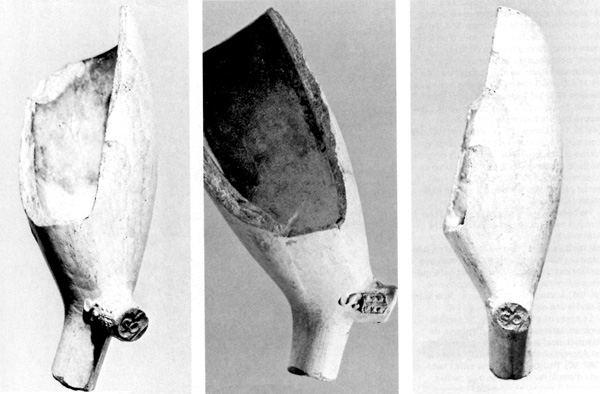
5 (a, left; b, center; c, right) Three
views of a Dutch pipe bowl. The letters S/V/O on the base of the heel
are the maker's mark, and the badge on either side of the heel is the
Gouda coat of arms surmounted by the letter S. This letter
(slegte: Dutch, ordinary), with the Gouda arms, was first
used in 1740, and indicates that this pipe belongs to the lower of the
three qualities of Gouda pipes, known in descending order, as
porcelain, fine, and ordinary, (The best-quality pipes
were not, in fact, of porcelain, but of polished clay.) (See p. 62.)
Context: 1755-60.
|
The history of the letters TD associated with clay pipes has already
been dealt with in some detail by the writer (Walker 1966a),
though more study of these pipes is still required. It is virtually
certain that the example here had on the front of its bowl (that is, the
side facing the smoker) the letters TD with a decorative motif above and
below, inside a thin rouletted circle, all impressed, similar to other
pipes described below. Pipes with a similar design are common from
camps of the period of the American Revolution (Calver 1931: 92, 93);
from Fort Ligonier, Pennsylvania, occupied between 1758 and 1765 (J. L.
Grimm, personal communication); from Fort St. Joseph, Michigan, which
was maintained by the French until about 1760; from an Indian
village site in Louisiana occupied intermittently until 1758 (both
quoted by Omwake 1965: 18-9, from an ambiguous reference in Quimby 1942:
545-6), and at Fort Michilimackinac where Omwake (1962; 1-2) tentatively
suggested a date of about 1755-65 for types that were possibly the
earlier of two main variants found there. They also occurred at Fort
Ticonderoga, New York (Gifford 1940: 128, 122, Fig. 13), founded in 1755,
and nearby Fort William Henry, 1755-57 (Omwake 1962: 9), but in unknown
contexts. On present evidence, therefore, TD pipes found at Louisbourg
are unlikely to date to earlier than the mid-1750s.
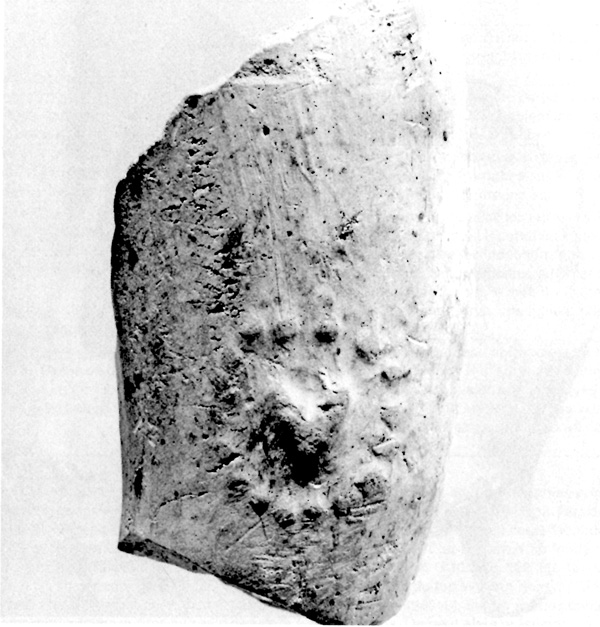
6 English bowl with design on its right side of an object resembling a
heart inside a circle of irregularly shaped dots. Context: 1755-60.
|
The most likely maker of these pipes appears to be Thomas Dormer, known
from two addresses in London in the 1760s (Oswald 1960: 68). The date on
which he received his freedom (became a licensed pipemaker) cannot be
later than 1763, the earlier of the two dates mentioned, but nothing
more is known of him, and no pipes of the type under discussion here are
in the collection of the Guildhall Museum, London (letters from A. H.
Hall, 18 March 1965 and R. Merrifield, 26 April 1965). Since he was
already working in the 1760s, however, he could have been working as
early as the 1750s.
The letters FS are not recorded by Oswald (1960: 91) before 1832:
however, from Casemate 3 Right a bowl with heel (4L.39, no object
number) was recorded and this had the letter F, crowned, on the left
side of the heel (the right side was broken off), and the letters FS
with the same decorative motifs and circle as that on the pipes bearing
the letters TD described above. Pipes with these letters, crowned, in
the same positions as in the example described above, on type 9 bowls
but with no design on the bowl, came from the Bankside excavations,
London (letter from R. Merrifield, Guildhall Museum, dated 26
April 1965). The use of crowns, though a typically Dutch form of marking,
is common in association with initials on either side of the heel on
pipes found in London covering the period from about 1690 to 1760
(Atkinson 1965: 254; 253, Fig. 6; 255, Fig. 7). The letters FS are not recorded at
Gouda, though a Frans Soet, who used the Gouda arms as his mark, gained
his freedom on 1 March 1737 (Helbers and Goedewaagen 1942: 170, No.
157), but the style of these pipes is certainly English and the letters
must represent some unknown maker.
There are too many makers with the initials RB or RR (14 of the former
between 1706 and 1766 and six of the latter between
1713 and 1774-90) to make further identification feasible (Oswald 1960;
60-1, 90). No name resembling "Dunier-" is recorded either in England or
Gouda, but the name and style of marking suggest it to be Dutch
or French rather than English (cf. Duhamel du Monceau 1771: 24-5, Pl.
IX, Figs. 20-1, Pls. I-IV passim).
Virtually the only example of dating evidence derived from bowl shape
alone comes from 32.7 (Fig. 8, right), an entire bowl and stem fragment.
The relatively upright position of the bowl indicates that it is at least
typologically late, verging towards Oswald's type 11 which he dates to
1780-1850. An example very similar to but smaller than the one under
discussion came from Casemate 4 Right (4M.27.1) and was regarded by
Omwake (1965: 26) as being late, possibly intrusive, in terms of the
probable occupancy of these casemates. He dated the specimen to 1750-60,
but the present writer would not be prepared to preclude the
possibility of a slightly later date.
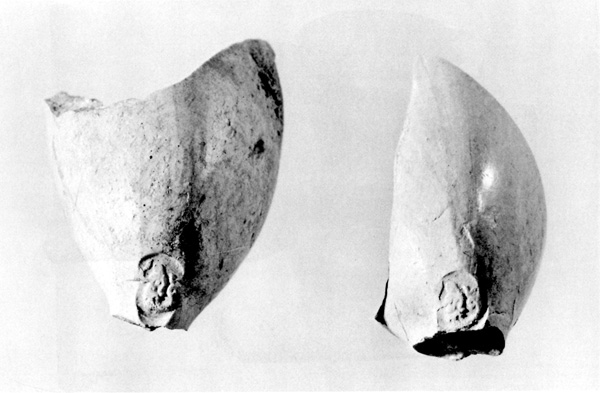
7 Two Dutch bowls with mermaid mark impressed on base of bowl. Contest:
both 1755-60.
|
|
| Layer 3 |
|
| 17.3: |
Entire bowl and heel, with crowned W on left side of heel, crowned M (?) on right, all raised. |
|
| 17.4: |
Heel and stem fragment, with crowned F on left side of heel, crowned S on right, all raised. |
|
| 17.5: |
Stem fragment with letters  and a line above, impressed, large shallow letters, widely spaced. and a line above, impressed, large shallow letters, widely spaced. |
|
| 35.1: |
Bowl fragment bearing part of encircled and decorated TD facing smoker, as described previously. |
|
| 54.1: |
Bowl fragment with heel, a crowned 14 raised from a depressed surround on the
foot of the heel and the arms of Gouda raised on a projection surmounted
by a raised letter S on either side of the heel. |
|
| 59.1; |
Heel and stem fragment, possibly a T on left side of heel, D on right, in small raised letters. |
|
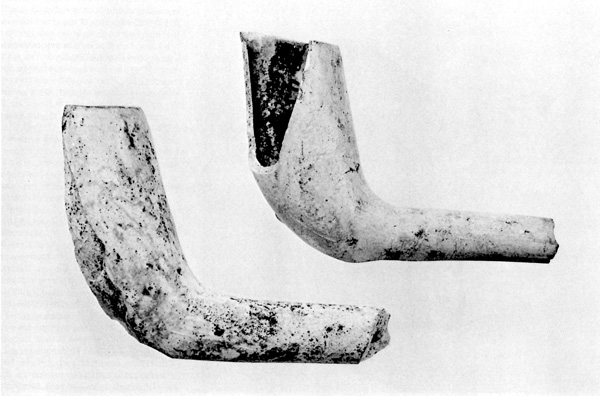
8 Two English bowls of typologically late (in terms of Louisbourg) date
— possibly 1760s and later. Context: both 1755-60.
|
Helbers and Goedewaagen (1942: 213) do not list owners of the crowned 14
before the 19th century, but their illustration of a portable board
carrying 18th-century marks shows this mark, though uncrowned (Pl.
VIII). The use of the coat of arms and the letter S point to a date
later than 1740.
The pipe stem marked  appears to have been made by John Stephens
of Newport, who is mentioned in the Apprenticeship Rolls for 1751
(Oswald 1960: 92), although usually Stephens used much smaller, sharply
impressed letters set closely together, as will be illustrated later.
However, as six of Stephens' pipes with the latter form of lettering
came from Casemates 13-15 Right, where the terminal date for occupation
is about 1732, Stephens must have been working for at least 20 years
before his only recorded date; thus the fragment here does not
necessarily indicate a late date. It may, in fact, be an imitation of a
genuine Stephens pipe. However, from an unknown part of the fortress, a
pipe was found with the standard Stephens mark on its stem but with a
bowl on which were floral decorations. Such a bowl would not usually be
dated much before 1800, so there may have been a father and son of the
same name, at present unrecorded. (Since this was written D. R. Atkinson
[information via A. Oswald, November 1968] notes that a pipe made by
John Stephens is in Southhampton Museum and must be that of a local
[Southampton-Portsmouth-Isle of Wight] maker of the first half of the
18th century. This would agree with the Newport mentioned, a Newport
being on the Isle of Wight.) appears to have been made by John Stephens
of Newport, who is mentioned in the Apprenticeship Rolls for 1751
(Oswald 1960: 92), although usually Stephens used much smaller, sharply
impressed letters set closely together, as will be illustrated later.
However, as six of Stephens' pipes with the latter form of lettering
came from Casemates 13-15 Right, where the terminal date for occupation
is about 1732, Stephens must have been working for at least 20 years
before his only recorded date; thus the fragment here does not
necessarily indicate a late date. It may, in fact, be an imitation of a
genuine Stephens pipe. However, from an unknown part of the fortress, a
pipe was found with the standard Stephens mark on its stem but with a
bowl on which were floral decorations. Such a bowl would not usually be
dated much before 1800, so there may have been a father and son of the
same name, at present unrecorded. (Since this was written D. R. Atkinson
[information via A. Oswald, November 1968] notes that a pipe made by
John Stephens is in Southhampton Museum and must be that of a local
[Southampton-Portsmouth-Isle of Wight] maker of the first half of the
18th century. This would agree with the Newport mentioned, a Newport
being on the Isle of Wight.)
Oswald (1960; 84) lists seven pipemakers with the initials WM between
1698 and 1775. One of these, William "Morley" of Liverpool, noted in
1767, was in fact William Morgan who gained his freedom in that year
(Omwake, personal communication, 1965), and the William "Morley" noted
by Oswald in Liverpool in 1803 was William Morgan (junior) who gained
his freedom in 1803. A. Noêl Hume (1963: 23) noted that pipes bearing
these initials in various forms — on the base of heelless pipes and
on either side of the heel, plain or surmounted by crowns or sunbursts
— are common in Williamsburg, Virginia, in deposits usually datable
to 1750-65, though they had also been found in a deposit that appeared
from a Binford calculation to date to about 1740. A. Noêl Hume suggested
William Meakin of Chester who became a freeman in 1747. Until Liverpool
eclipsed it towards the end of the 18th century, Chester was a major
pipemaking centre; thus Meakin certainly seems a more likely maker than
the only other known maker with these initials between 1700 and 1747,
William Mellor of Bolsover, Derbyshire, apprenticed in 1723. Mellor
probably catered to a very local demand in a country area.
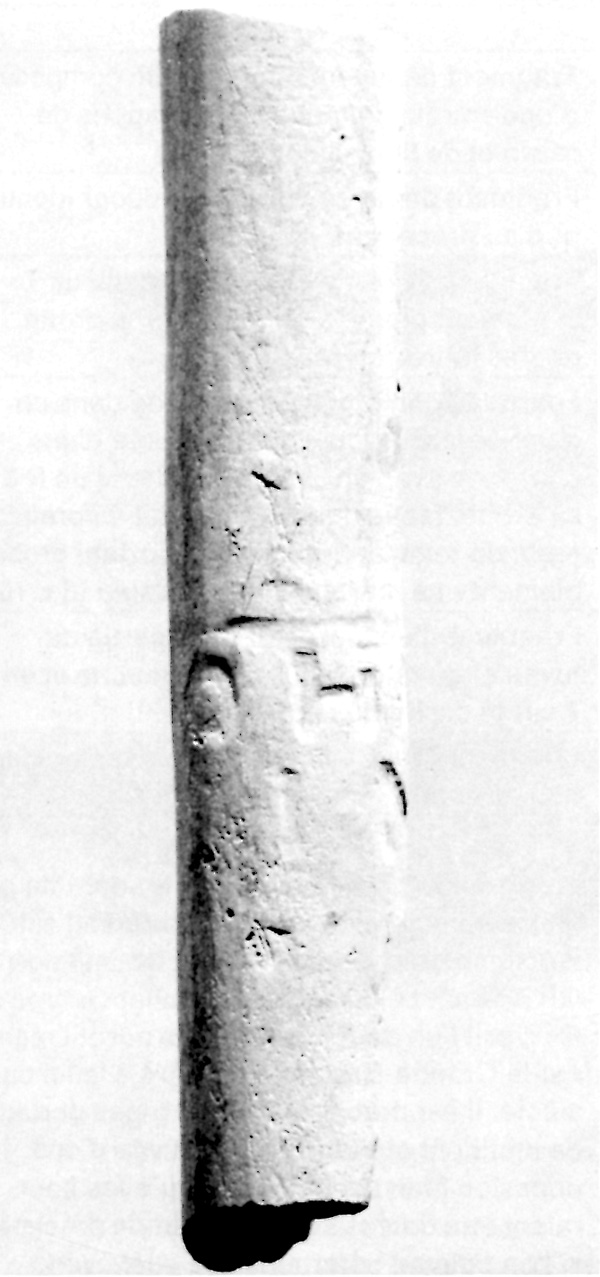
9 Stem fragment with letters OHST/INZ and a line above, impressed;
perhaps an imitation of the mark of John Stephens of Newport, England,
fl. 1751 (cf. Fig, 15). Context: 1755-60.
|
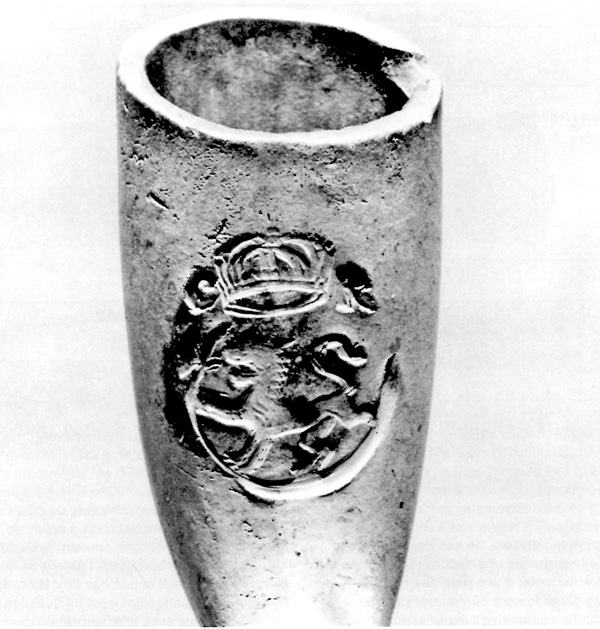
10 English bowl with lion guardant holding a halberd with a
semi-circular line round and below, surmounted by a crown with G on its
left and R on its right, facing the smoker, all impressed. Context:
1755-60.
|
Atkinson (1965; 253, Fig. 6; 254; 255, Fig. 7; 256) notes that among
pipes found in London, the initials WM, with and without the crowns,
occur on either side of the heel of pipes datable typologically from
about 1690 into the second half of the century; but Oswald lists no
known London makers with these initials during this period.
One fragment with these
letters crowned, one on either side of the heel (4F.6.19), came from Casemate 14 Right,
apparently in a 1720-32 context, but was perhaps intrusive from the fill
above. From Casemate 3 Right, a bowl and heel (4L.1.7) had the letters
WM, crowned, on either side of the heel; and these letters with the same
decorative motifs and rouletted circle as those described on bowls with
the letters TD and FS facing the smoker. From Casemate 5 Right
(4N.16.4) a bowl with identical decoration to one to be described (Fig.
10) had on either side of its heel the letters W
and M, each crowned. The example in Figure 10 has lost its heel. The
letters WM are not listed by Helbers and Goedewaagen but are
illustrated, crowned, on an 18th-century portable board of pipe marks
(Helbers and Goedewaagen 1942, Pl. VIII). Helbers subsequently noted
(quoted by Omwake 1965, letter: 5-6) that this mark, uncrowned, was in
use in Gouda in 1726; that it was subsequently crowned, and that it
lasted in that form until 1809. The pipes in question here, however, are
certainly English.
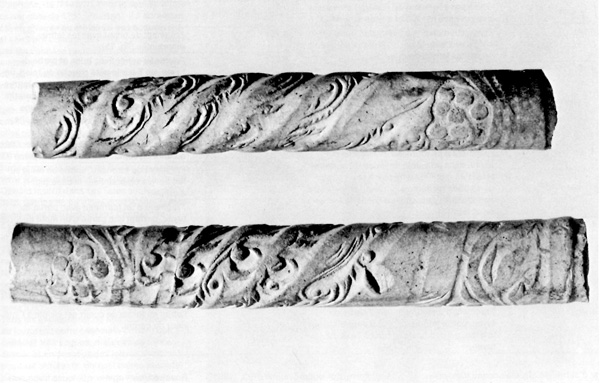
11 Two stem fragments with identical decoration of
a spiral of leaves. grape bunches, and rouletted
lines. Context: both 1755-60.
|
The use of the decorative motifs above and below the letters TD, FS, and
WM and their surrounding with a rouletted circle occurs with the letters WG
also; and pipes bearing these last letters, like those with the letters
TD, are known from camps dating to the American Revolution (Calver
1931: 2, 93). Pipes bearing the letters WM and FS in this style should
therefore be broadly contemporaneous in date, and thus late in terms of
Louisbourg's history. There must be some connection among these four
distinctive marks, but what this is has still to be determined (Cf.
Walker 1966a).
Proof of the widespread popularity of the TD and TD-derived marks comes
from excavations of the factory in Drammen, Norway,
about 25 miles southwest of Oslo belonging to Jacob Boy, a pipemaker who
was in business from 1751 to 1770. In common with other Scandinavian
pipemakers he manufactured pipes in both English and Dutch styles, and
one of the former was a bowl of the same shape as the TD-marked pipes
described above, with the letters IB facing the smoker but otherwise
identically marked, and the letters I and B on either side of the heel
(Pettersen and Alavik 1944: 53, illus. on p. 49).
|
| Layer 4 |
|
| 7.1: |
Entire bowl and heel, crowned W on left side of heel, crowned M on right. |
|
7.
(no object number): |
Mouthpiece fragment with a post cocturam coating of red wax. |
|
| 22.2: |
Bowl fragment, heel and part of stem, T on
left side of heel, either ID or two half-superimposed Ds on right, in large raised
letters as described above; part of an encircled and decorated TD on bowl facing smoker. |
|
| 22.3: |
Bowl fragment with figure 8 impressed on base parallel to line of stem. |
|
| 22.15: |
Heel with bowl and stem fragments, T on left side of heel, D on right in
large raised letters. |
|
| 37.1: |
Stem fragment, elaborately decorated with a spiral of leaves, grape
bunches, and rouletted lines. |
|
| 39.1: |
Stem fragment with identical decoration to above. |
|
| 41.1: |
Bowl fragment with heel, T on left side of heel, D on right in small raised letters. |
|
| 66.1: |
Complete bowl, lion guardant with semi-circular line around and below, surmounted
by a crown with G on its left and R on its right, facing the smoker, all impressed: the
beginning of a presumed heel is visible and on this is possibly part of an indecipherable mark (Fig. 10). |
|
| 66.2: |
Bowl fragment, heel and stem fragment, H
on left of heel, T on right. |
|
| 75.2 and 3: |
Stem fragments with identical decoration to 37.1 and 39.1 (Fig. 11). |
|
Material from Layer 4 is less readily datable than in Layers 3 and 2:
the pieces with the letters TD point to a date approximately the same
as these layers, but the heavily decorated stems are fairly closely
paralleled on the one hand from a rubbish pit in Chester which contained
material datable to the first three decades of the 18th century (Webster
and Barton 19S7; 20, 24), and on the other to material from the military
site at Penetanguishene, Ontario, occupied between 1826 and 1856, which
Omwake (1965, letter: 6-7; the material has not been seen by this
writer) notes as being typical of the 19th century. Spence (1942: 53,
51, Pl. IV, 1) suggests that an identically decorated stem to that
illustrated by Webster and Barton was made by Randle Meakin (brother of
William referred to previously), who became a freeman in 1721, or by his
son of the same name who became a freeman in 1784. Randle (senior) was
apparently working at least as late as 1758 (Spence 1942; 64). In view
of the known tendency of 18th-century Chester manufacturers to make
pipes with elaborate stem decoration, it is reasonable to ascribe these
three fragments to these makers. Although from the 17th century
onwards, Dutch pipemakers produced pipes with decorated stems, frequently
very heavily done in baroque ornament, the present writer knows of no
Dutch parallels to the decoration discussed here. A stem fragment with
the same decoration came from Casemate 3 Right (4C.39.93),
unfortunately from unrecorded digging there in the summer of 1962.
The bowl bearing the lion guardant and crown is the one already
mentioned as being identical to one with a heel bearing the letters W
and M, crowned, from Casemate 5 Right (4N.16.4). (Similar bowls are
known from London and one from Port Royal, Jamaica [Oswald, personal
communication], but none was in a datable context, and that from Port
Royal is certainly later than 1692 when much of that port was destroyed
by an earthquake.) The bowl is certainly English and the letters GR
presumably stand for Georgivs Rex, one of the three Georges, kings
of Great Britain from 1714 throughout the rest of the century. It seems
likely that pipes with this design were manufactured for a specific
occasion, and thus may be very closely datable it the event can be
determined. Unfortunately, the example from Casemate 5 Right came from
an area excavated by machine and its context cannot now be known.
As already noted, letters surmounted by crowns, including the letters
WM, occur from early in the 18th century, but it we take the Williamsburg
evidence that they occur normally about 1750-65 there, the obvious event
to be recorded by this design would be the accession of George III in
1760. An alternative but less likely explanation could be that the
design was produced as a patriotic gesture to mark the end of the War of
Spanish Succession in 1748. It the maker was indeed William Meakin, then
the pipe cannot be earlier than 1747, but it the occurrence of the
letters W and M, some with crowns, and in a context datable to about
1740 at Williamsburg is substantiated, then Meakin cannot be responsible
for these examples at least, and the patriotic gesture could have been
made during the troubled times in Britain of the Jacobite rebellion of
1745-46. The bowl shape is well-developed, and while the plane of the
rim of the bowl is not parallel with the line of the stem, this feature
is known on TD bowls from Fort Michilimackinac, which Omwake tentatively
dates to about 1755-65 (Omwake 1962: 1-2; cf. Duhamel du Monceau 1771:
4, Fig. 19). It should be dated later than 1727, when George I succeeded
his father.

12 Dutch bowl with the crowned 6 mark. Single coat of arms of the city
of Gouda indicates this pipe belongs to the upper classes of Gouda pipes
(cf. Fig. 5). See p. 62. Context: 1755-60.
|
The initials HT belong to three known 18th-century English pipemakers
(Oswald 1960: 96); Henry Turner who worked in London between 1707 and
1732, Henry Tucker of London who died in 1741, and Henry Tapplin of
Easworth, Hertfordshire, who is mentioned in 1750. From this it appears
that pipes bearing these initials were being manufactured all through
the period of occupation of Louisbourg.
The use of the figure 8 cannot be identified. The use of numbers was
another characteristic of the Dutch, but neither the style of number
nor the form or quality of the fragment show any Dutch influence. Had
this fragment and others like it described later come from unsealed
layers, it could have been suggested that they belonged to 19th-century
pipes, for by this time the use of numbers to denote styles and other
information on pipes was known (Omwake 1957a; 8; Walker 1966a:
88-9).
According to Fairholt (1859; 173) and Cassidy (1895: 18), the Dutch
were the first to wax the ends of their pipestems about 1700; and the
English quickly followed, using either wax (usually red) or a glaze
(Cooper 1907:108), a tin glaze which turned green on firing according to
Omwake (1965: 30). Omwake states that these methods appear to have been
used only on the best-quality pipes, for it is recorded (Cassidy 1895:
18) that the custom of dipping the stem in ale for a few minutes before
use was the practice for ordinary pipes. (The author knows of an
octogenarian in England who still [1968] does this with his clay pipes.)
According to Parsons (1964: 232, quoting two sources dated 1693), both
glazed pipes and glazed mouthpieces were common in the 17th century, but
the reference to glazed pipes seems certainly to refer to polished
pipes (Houghton 1727; 205; though published in 1727, this work first
appeared in 1693/94). Jewitt (1878 I: 298) extols glazed mouthpieces as one
of the merits of the pipes of an Edwin Southorn, working at Broseley in
the 1850s and 1860s, and implies that the custom was unusual. (It must
be admitted, however, that this particular account by Jewitt is
erroneous and contradictory in parts.) At Rosewell, Virginia, datable to
about 1772, a few mouthpiece fragments were found with coated or glazed
ends. One had a post cocturam red wax finish, as with the example here;
another had an ante cocturam black slip, and others had a treacly brown
glaze or a bluish green glaze flecked with light brown or orange (I.
Noêl Hume 1962: 221).
|
| Deposit containing Material from Layers 2, 3 and 4 (Intrusion 1) |
|
| 4.14: |
Stem and heel fragment, T on left side of heel, D on right in small
raised letters. |
|
| 4.15: |
Complete bowl and part of stem, a crowned 6 raised from
a depressed surround and enclosed in an oval on base of bowl, and arms
of city of Gouda similarly beside it to the left; the mouth of the bowl
has a milled edge (Fig. 12). |
|
| 4.16: |
Bowl fragment and part of stem, EC within a circle with a motif
resembling a modern trophy cup above letters and an illegible design,
perhaps a heart, below, all raised (Fig. 13). |
|
| 4.17: |
Heel and bowl fragment, with crowned W on left side of heel, crowned M
on right, all raised. |
|
| 4.18: |
Bowl and stem fragment with figure 8 impressed on base sideways to stem
(Fig. 14). |
|
| 4.19: |
Bowl and stem fragment with lower part of figure 8 impressed
on base transversely to stem. |
|
| 4.20: |
Stem fragment with  impressed on it (Fig. 15). impressed on it (Fig. 15). |
|
| 9.2: |
Complete bowl, heel and part of stem, T on left side of heel, D on right
in small raised letters, encircled and decorated TD facing smoker as
described previously (Fig. 16, right; Fig. 17, right). |
|
| 9.3: |
Complete bowl with heel broken off, decoration facing smoker as
described in 9.2 above. |
|
| 9.4: |
Bowl fragment, mermaid in oval impressed on base (Fig. 7, right). |
|
| 18.3: |
Bowl and stem fragment bearing part of a
decoration the same or similar to that already described in Layer 2, 32.5 and 32.6;
part of a circle of slightly raised dots is visible and something is raised inside this. |
|
18.
(no object number): |
Two bowl fragments with the same design as 18.3 above: in both the
heart-like object inside the circle is visible. |
|
The mermaid cipher of Gouda has already been discussed, and while it
may date only from 1745, it is not possible to be certain of this.
The pipestem marked  , like that mentioned earlier from Layer 4,
though the latter has a different style of letters, appears to have been
made by John Stephens of Newport, whose only known date is 1751. He must
have been in business for at least 20 years previously, however, on the
evidence from Casemates 13-15 Right, as six stem fragments with his name
have been found there, which dates them prior to 1732. , like that mentioned earlier from Layer 4,
though the latter has a different style of letters, appears to have been
made by John Stephens of Newport, whose only known date is 1751. He must
have been in business for at least 20 years previously, however, on the
evidence from Casemates 13-15 Right, as six stem fragments with his name
have been found there, which dates them prior to 1732.
Pipes found in Britain with initials on the side of the bowl are
restricted in distribution, though they are common in America (Oswald
1959: 59). Oswald does not list an encircled EC amongst those depictions
known, chiefly from the Bristol area in England (Oswald 1961: 56).
Elsewhere (1960: 63) Oswald lists only two known English pipe makers
with these initials: Evans Cheever of Canterbury who became a freeman in
1741, and Elisha Clanno of Exeter working about 1780. Either of these
pipemakers would agree with the late (in terms of Louisbourg) date
suggested by the previous evidence, though the latter must almost
certainly be too late. All the examples of these bowls from the casemate
have very indistinct marks, but the decorations above and below the
letters do appear to differ, or are even non-existent in certain
examples. The same can be said for the pipes with this mark from
Casemate 4 Right (Omwake 1965: 15-6). Proof of the varying nature of the
decoration comes from two well-preserved specimens, one from Casemate 5
Right (4N.7.22) where no decoration appears save for a colon between the
letters, and one from one of the basements of the Chateau St. Louis
(16D.4.9) showing a rather squat, solid crown above the letters and
below, a solid ace of clubs.
The crowned 6, a Gouda mark, as remarked previously, offers no
definite dating evidence other than its occurrence in Layer 2 and at the
contemporary site of Santa Rosa Pensacola (Omwake 1964). Similarly, the
figure 8 also offers no definite dating.
|
| Layer 5 |
|
| 36.1: |
Heel and stem fragment, crowned W on left
side of heel, crowned M on right. |
| 43.2: |
Bowl fragment, heel and part of stem, T on left side of heel, either D
or two half-superimposed D's on right in large raised letters,
encircled and decorated TD on bowl facing smoker identical to examples
previously described (Fig. 16, left; Fig. 17, left).
The occurrence of both these marks in
the previous layers suggests this particular
layer to be approximately contemporaneous with them. |
|
| Layer 6 |
|
|
No significant pipe material was recovered from this layer. |
|
| Layer 7 |
|
| 24.1: |
Heel and stem fragment, crowned F on left of heel, crowned S on right. |
|
| 83.1: |
Bowl, RT impressed on it facing the smoker,
 inside a circle, all raised, on right side
of bowl (Fig. 18, bottom right; Fig. 19, right). inside a circle, all raised, on right side
of bowl (Fig. 18, bottom right; Fig. 19, right). |
|
The occurrence of the first mark in previous layers suggests this could
have been deposited approximately at the same time as the others;
however, the Tippet pipe may be appreciably earlier. There was a number
of Tippet pipemakers in Bristol in the latter part of the 17th century
and the earlier part of the 18th, and one branch of the family comprised
three generations all called Robert. Omwake (1958) and Oswald (1959)
have dealt with this branch of the family. The first-named appears to be
the more accurate account, and recently Omwake (1964: 20-3; and letter
dated 16 March 1965: 7-8) has supplied additional material.
The first Robert Tippet became a freeman in 1660 and died between 1661
(when he took an apprentice) and 1689 (when his wife is referred to as a
widow with an apprentice free that year). Presumably he was dead by
about 1682, for his widow apparently had her apprentice the full seven
years of legal apprenticeship, but Omwake's reasoning for 1680 is wrong
— his source has a comma omitted which wrongly implies the wife
had been a widow seven years in 1687. The second Robert became a freeman
in 1678 and was still alive in 1713. Meanwhile, his widowed mother
J(o)ane appears to have carried on her late husband's business, at
least until the turn of the century, for she is recorded in 1696. (There
are references in the records to both a Jane and a J(o)ane Tippet, whom
Oswald [1960: 96] lists as two different persons, but Omwake [1958: 5; 1964:
22] shows that they are in fact one and the same person.) The third
Robert became a freeman in 1713 and either he or his father is referred
to in 1720.2
It is extremely difficult to differentiate pipes made by various
members of this family, but the first Robert is unlikely to have been
making pipes of the type 9 shape, as he died just about the time these
pipes were beginning to appear. The rapidity with which this shape
gained in popularity, however, is indicated by the appearance of this
type with  in the medallion on the right side of the bowl, for
this almost certainly identified pipes made by J(o)ane Tippet and thus
can be dated, at the very latest, only to the earliest years of the 18th
century. One of these pipes found in this casemate is described later.
Omwake (1958: 12) tentatively suggested that the second Robert may have
started with the impressed RT on the back of the bowl, later adding the
medallion on the side, and that the third Robert may have used the
medallion without the RT, in which case all those at Louisbourg of
which enough evidence survives to make this assumption certain would
have been made by the second Robert. Gifford (1940: 128-9, 122, Fig. 14)
shows examples of Tippet pipes from Fort Ticonderoga distinctive in not
having the RT on the bowl. It any one of the Robert Tippets was still
working by 1755 when the fort was founded, then it would be the third,
thus agreeing with Omwake's suggestion. None of the material from Fort
Ticonderoga was excavated stratigraphically and it could be argued that
Robert Tippet pipes found there represent some prior settlement, either
Indian or European. These pipes are common on Onondaga and Oneida sites
dating from before 1700 to about 1750 (Hagerty, personal
communications). (Three were found, however, by the writer in the summer
of 1966 while excavating the closely dated site of Fort Gaspereau, New
Brunswick [1750-56]. indicating that the pipes, it not the maker, were
in existence as late as the 1750s. Further, two Tippet pipes were found
during excavation in 1969 of a wreck in Baie-des-Chaleurs, on the
Quebec-New Brunswick border, which was datable to 1760 [information from
R. Grenier, National Historic Sites Service].) in the medallion on the right side of the bowl, for
this almost certainly identified pipes made by J(o)ane Tippet and thus
can be dated, at the very latest, only to the earliest years of the 18th
century. One of these pipes found in this casemate is described later.
Omwake (1958: 12) tentatively suggested that the second Robert may have
started with the impressed RT on the back of the bowl, later adding the
medallion on the side, and that the third Robert may have used the
medallion without the RT, in which case all those at Louisbourg of
which enough evidence survives to make this assumption certain would
have been made by the second Robert. Gifford (1940: 128-9, 122, Fig. 14)
shows examples of Tippet pipes from Fort Ticonderoga distinctive in not
having the RT on the bowl. It any one of the Robert Tippets was still
working by 1755 when the fort was founded, then it would be the third,
thus agreeing with Omwake's suggestion. None of the material from Fort
Ticonderoga was excavated stratigraphically and it could be argued that
Robert Tippet pipes found there represent some prior settlement, either
Indian or European. These pipes are common on Onondaga and Oneida sites
dating from before 1700 to about 1750 (Hagerty, personal
communications). (Three were found, however, by the writer in the summer
of 1966 while excavating the closely dated site of Fort Gaspereau, New
Brunswick [1750-56]. indicating that the pipes, it not the maker, were
in existence as late as the 1750s. Further, two Tippet pipes were found
during excavation in 1969 of a wreck in Baie-des-Chaleurs, on the
Quebec-New Brunswick border, which was datable to 1760 [information from
R. Grenier, National Historic Sites Service].)
Oswald (1959; 61) notes that at one excavated kiln site in Bristol,
Tippet pipes of heeled, spurred, and heelless types were found, and at
another, heelless ones only, suggesting, in view of the finding in North
America of the last type only, that Tippet enterprises had a large
enough business to specialize in export only models. Even in today's
attenuated pipe industry, the firm of C.B. and McDougall of Glasgow
(Walker and Walker 1969), successors of D. McDougall Ltd. (founded in
1846, not as Fleming [1923: 243] states, 1810) had, until they closed in
November, 1967, between 30 and 40 moulds in operation to satisfy
different tastes in different parts of the world (Knight 1961: 34). The
occurrence of Oswald's type 9 pipes so exclusively in North America may
have been because of a similar predilection. Omwake (1958: 6) has
suggested that Tippet pipes found in England with the RT on the bowl
but not the medallion might be for the home market, and certainly all
New World Tippet pipes seem to have the medallion.
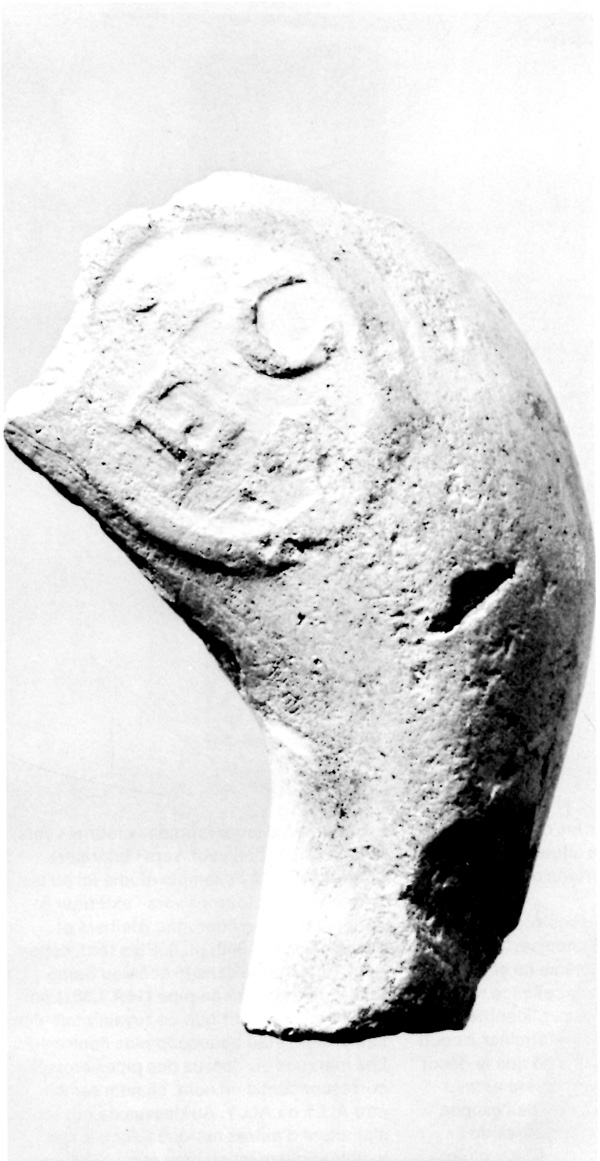
13 English pipe. EC within a circle with a motif resembling an antique
urn above letters and an illegible design, perhaps a heart, below; all
raised. Possibly the mark of Evans Cheever of Canterbury, fl. 1741.
Context: 1755-60.
|
|
| Layer 5/6/7 |
|
|
In some places, because of the thinness of Layers 5, 6 and 7, it was not
possible to differentiate them with certainty. The material described
here represents what was found in these areas. |
|
| 113.1: |
Heel, bowl and stem fragment, T on left
side of heel, D on right in small raised letters. |
|
| 115.1: |
Bowl fragment and portion of stem, fragment
of circle and bottom edge of letter raised on right side of bowl, perhaps EC
as below. |
|
| 115.2: |
Complete bowl and stem fragment, letters
EC with urn-like object above but apparently nothing below (cf. deposit containing
material from Intrusion 1; 4.16), encircled, all raised.
This mixture of layers contains nothing
previously unnoted in the way of dating material, and appears to be approximately
contemporaneous with the previous layers. If the letters EC belong to either known
pipemaker with these initials, a post-1741 date is indicated. |
|
| Layer 8 |
|
| 87.3: |
Stem fragment, crossed spurred pipes of
Dutch type and an apparent E on its back
above the bowls of the pipes, all impressed
(Fig. 20). |
|
| 106.1: |
Bowl fragment and stem fragment, EC with urn above and indecipherable
object below, all enclosed in a circle, all raised as described
previously. |
|
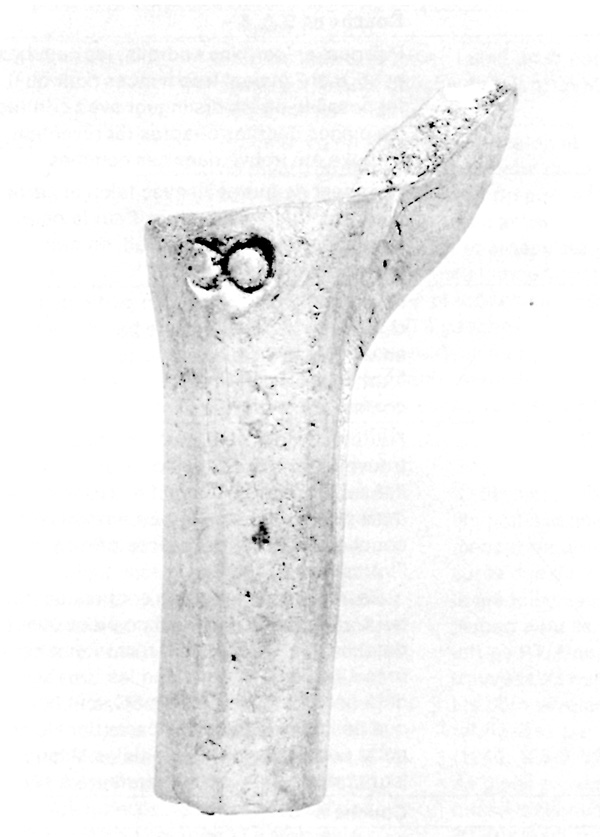
14 English pipe with figure 8 impressed on base at right angles to line
of stem. Context: 1755-60.
|
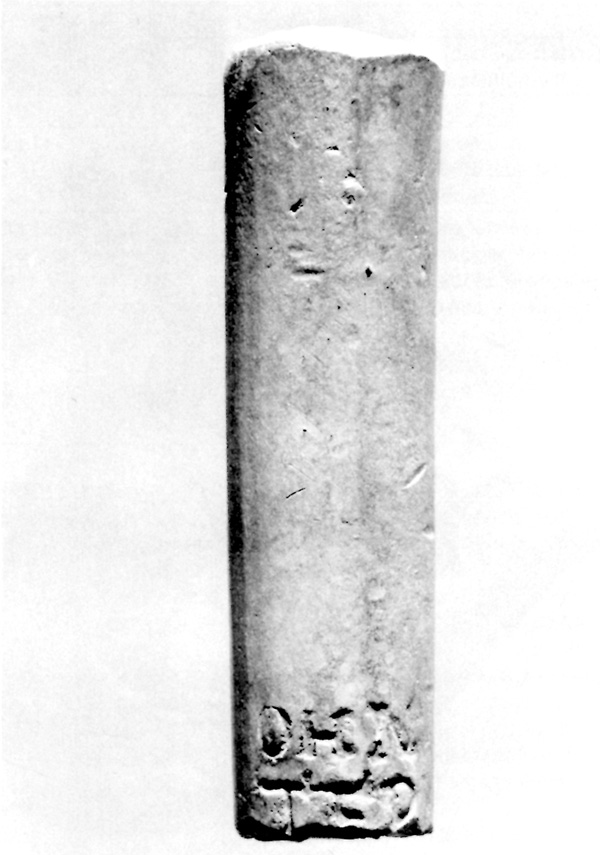
15 Stem fragment with OHN/TEP impressed; John Stephens of Newport,
England. fl. 1751. Context: 1755-60.
|
The piece with the letters EC is identical to other finds in previous
layers, suggesting the approximate contemporaneity of this deposit and
the other finds.
The crossed pipes, as mentioned above, are of Dutch shape, but the
standard both of the decoration and the stem itself seems to fall short
of the normal Dutch excellence. No definite identification can be found,
it was at first thought that the decoration represented a crude and
inaccurate version (perhaps forged) of the badge of the Gouda pipemakers
guild, which was two crossed pipes with their bowls up (unlike this
example where the bowls face out) surmounted by a crown (Helbers and Goedewaagen 1942: Pl. I). Subsequently,
however, a stem fragment (16A.1.381) bearing the same design as this
stem, but with a more legible imprint, was recorded from the Chateau St.
Louis. The marks above the crossed pipes are now revealed to be a name;
the letters appear to read ALLT or ALLY, and above this again there are
marks tentatively deciphered as IOHN, though only the O is definite. No
pipemaker of a name resembling this is known either in England or The
Netherlands, and the name itself does not definitely indicate its
nationality. The pipes depicted on the stem, however, are certainly Dutch in shape.
From its form, one bowl from this layer, 13.3 (Fig. 8, left), might be
construed as being relatively late. The bowl is more upright than most
of those found in this area, and approximates one from Layer 2 (Fig. 8,
right), which was compared earlier with a larger but otherwise similar
bowl from Casemate 4 Right, for which a 1750-60 or later date was
suggested (Omwake 1965:26). This particular example (13.3) is larger
than the one from Layer 2 though not as large as the example from
Casemate 4 Right.
|
| Layer 9 |
|
| 73A.1: |
Bowl fragment and heel, of characteristic
Dutch shape and finish, with a crown surmounting what appears to be a claw
hammer on base of heel; the mouth of the bowl has a milled edge. |
|
| 73A.2: |
Complete bowl and heel, of characteristic
Dutch shape and finish, with a mark which
appears to be a hollow circle surmounted
by a barbell on base of heel; the mouth of
the bowl has a milled edge. |
|
| 73A.3: |
Bowl fragment and stem fragment, ER
impressed on bowl facing smoker (Fig. 21). |
|
| 73A.4: |
Complete bowl and heel, RT impressed on
bowl facing smoker, apparently an extremely faint shield-like badge with a cross
above on right side of bowl; underneath the
shield is what appears to be an asymmetric
inverted V, though this may be merely a
nonsignificant pattern, the whole raised and
enclosed in a raised circle (Fig. 18, top). |
|
| 73A.5: |
Stem fragment with complex decoration
comprising a transverse band of round dots
each surrounded by a circle, between
double parallel lines, followed by a panel
with barbell-like motifs parallel to each
other and lying parallel to the stem, followed
by a repetition of the barbell motif; the one
end of the decoration visible on this fragment
is edged with ogee impressions lying
parallel to the stem (Fig. 22). |
|
| 88.1: |
Bowl fragment and stem fragment, a
crowned 6 raised from a depressed surround in an oval on base of bowl; the mouth
of the bowl has a milled edge (Fig. 23). |
|
| 88.2: |
Very small fragment of bowl wall with part
of medallion and the letters HT inside (only
right half of the letter H present) separated
by a star, surmounted by a pyramid of six
very small diamond-shaped dots, enclosed
in a circle cog-toothed inside and out, all
raised (Fig. 24, right). |
|
| 94.1: |
Bowl fragment and stem fragment, RT impressed on bowl facing smoker
(Fig. 19, left). |
|
| 94.2: |
Bowl fragment and stem fragment,  in
circle on right side of bowl, all raised
(Fig. 18, bottom centre). in
circle on right side of bowl, all raised
(Fig. 18, bottom centre). |
|
| 100.1: |
Stem fragment, with letters  impressed on it (Fig. 25).
impressed on it (Fig. 25). |
|
| 100.2: |
Bowl fragment and heel, W raised on left side of heel, other side
obliterated. |
|
| 100.3: |
Heel and stem fragment, crowned F on left side of heel, crowned S on
right, all raised. |
|
| 103.2: |
Stem fragment with half of a six-rayed star with circle in centre
surrounded by two concentric circles raised from a depressed background
(Fig. 24, left). |
|
| 109.7: |
Bowl fragment and heel fragment, EC very faintly marked with no
embellishments visible, encircled, all raised. |
|
| 121.1: |
Bowl fragment and heel, crowned B raised from a depressed surround on
base of heel. |
|
| 121.2: |
Bowl fragment and stem fragment, base of RT
impressed on bowl facing smoker visible,  in circle on right of bowl, raised (Fig. 18, bottom left).
in circle on right of bowl, raised (Fig. 18, bottom left). |
|
| 121.3: |
Stem fragment, heel and bowl fragment,  raised from a round-cornered, depressed square on top of stem, the name
running at right angles to the stem (Fig. 26).
raised from a round-cornered, depressed square on top of stem, the name
running at right angles to the stem (Fig. 26). |
|
| 121.5: |
Bowl fragment and stem fragment with raised encircled cartouche of R.
Tippet on right side of bowl as above, but because of deposit of rust
only final T of surname visible. |
|
| 121.7: |
Heel and stem fragment, crowned 10 raised
from depressed surround on base of heel. |
|
| 131.1: |
Entire bowl of typical Dutch shape and finish, indecipherable mark on
left side of base; the mouth of the bowl has a milled edge. |
|
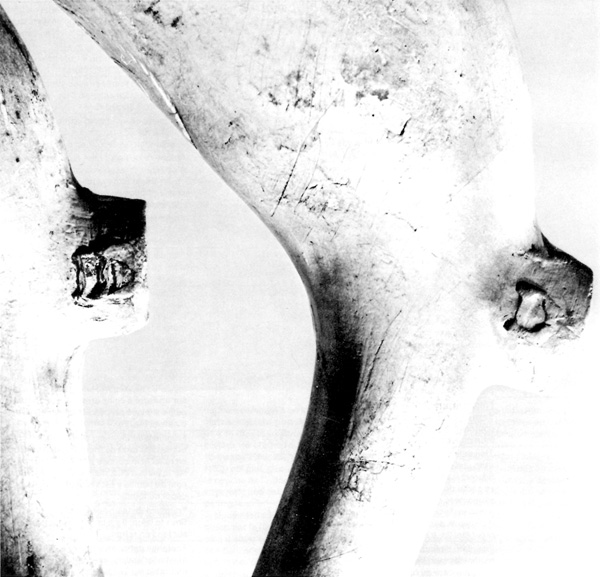
16 Two examples of English pipes with the letters TD; left, with
double D; right, single. Context: left, 1755; right,
1755-60.
|

17 Same two examples as in Figure 16, showing typical shape of English
bowl of this period; TB design on bowl and motifs below and above
letters and the rouletted enclosing circle.
|
Pipes made by the Tippet family have already been discussed and the
occurrence of five here suggests an earlier date than that deduced for
the previous layers. The absence from this layer of any pipes with the
letters TD, which are known to be late, and of which eleven were found
in the previous layers, reinforces this suggestion.
The Tippet pipe with the badge on the side was certainly not a
standard product of the family: indeed its occurrence seems completely
unrecorded to date. The heel suggests it may have been intended for the
English market. The pipe may have been intended to commemorate some
event, in which case it may ultimately be closely datable; but attempts
to identify it have so far failed. Pipes with the  as noted earlier, were in all probability made by J(o)ane Tippet, wife
of the first Robert Tippet, who apparently carried on her dead husband's
business after his death before 1682 until at least 1696. Pipes from a
site discussed by Omwake and Oswald also have the surname split in the
same place as this example despite coming from different moulds, and
other pipes illustrated by them use either
as noted earlier, were in all probability made by J(o)ane Tippet, wife
of the first Robert Tippet, who apparently carried on her dead husband's
business after his death before 1682 until at least 1696. Pipes from a
site discussed by Omwake and Oswald also have the surname split in the
same place as this example despite coming from different moulds, and
other pipes illustrated by them use either  (as examples 121.2) or (as examples 121.2) or  (as
in example 83.1). The (as
in example 83.1). The  pipe here is clearly identical to those
referred to by Omwake and Oswald; in fact, it these are made by the
widow of the first Robert Tippet the example in this layer is probably
the earliest pipe in the casemate, for it must date to the very
beginning of the 18th century at the latest. pipe here is clearly identical to those
referred to by Omwake and Oswald; in fact, it these are made by the
widow of the first Robert Tippet the example in this layer is probably
the earliest pipe in the casemate, for it must date to the very
beginning of the 18th century at the latest.
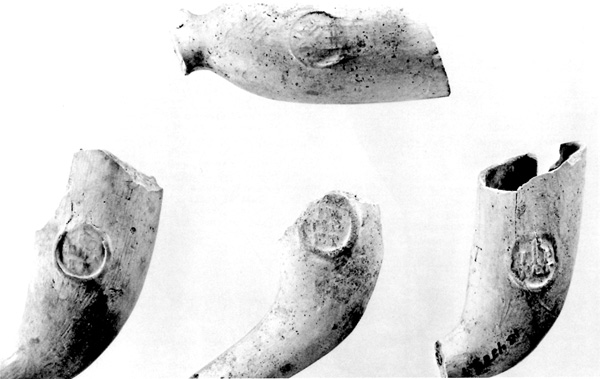
18 Four bowls manufactured by members of Tippet family of Bristol, all
with RT impressed on side of bowl facing smoker. Top, at present
apparently unique in North America, has heel and what appears to be a
badge in the medallion which normally takes the Tippet name. Bottom
left has R/TIP/ET inside medallion; bottom centre has IR/TIP/ET and
bottom right R/TI P/PET indicating the use of different moulds. Bottom
centre made by J(o)ane Tippet (see text). Remaining examples made by
second or third Robert Tippet, or both, who between them covered the
period from 1678 to after 1720. Context: top, bottom left, and centre:
ca. 1716-49/50; bottom right: 1749/50-55.
|
Nevertheless, the occurrence of two bowls marked EC, already noted in
upper layers and discussed earlier, would suggest a much later date for
the deposition of this layer if the identification of these initials is
correct; and the occurrence of a pipe with the letters FS, both crowned,
two other examples of which occurred in upper layers, suggests the same
conclusion.
The complexly decorated stem 73A.5 appears to be Dutch in origin, for
the decoration is paralleled on two stems with bowls attached from
Casemates 13 Right and 14 Right (4W.3.112, Fig. 38, and 4F.6.391, Fig
44, respectively), which have on the heel a crowned LV with what appears
to be a bird flying below. While this mark is not recorded by Helbers
and Goedewaagen, it is typically Dutch; and the bowl shape, while not
among the usual ones illustrated in Figure 27, may be a contemporary
of the type with the plane of its bowl parallel to its stem which,
brought to England in 1688, inspired the type 9 shape and its variants,
and ultimately was responsible for the shape that came to be associated
with all English clay pipes. Thus the shape itself, which appears not to
have caught on in The Netherlands, implies a relatively early date in
terms of Louisbourg; a supposition strengthened by its occurrence in
the right face casemates which were tilled about 1732.
The crowned 10 is also a Gouda mark, it is not listed by Helbers and
Goedewaagen, but one of their illustrations (Pl. VIII), captioned only
as 18th century, shows it.
The crowned 6, another Dutch mark, has already been referred to.
However, in this case, the coat of arms of Gouda is not present and it
seems probable, though not entirely certain, that this pipe dates to
before 1739-40.
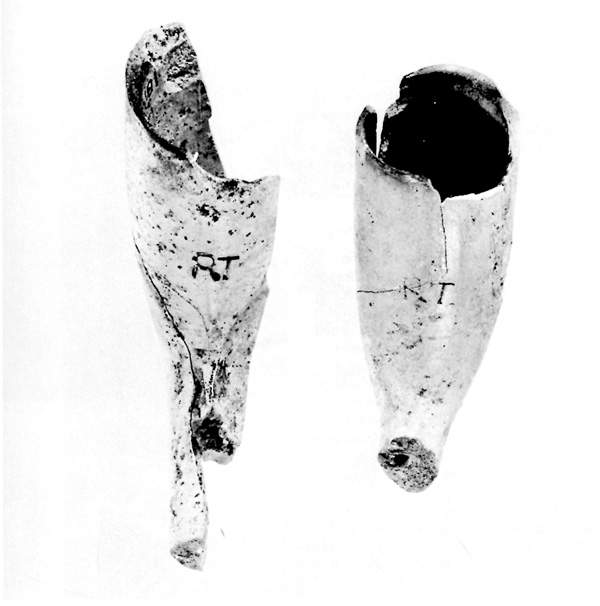
19 One of the bowls shown in Figure 18 and another showing RT impressed.
|
The crowned B, also Dutch, was originally registered in 1661. The
earliest known owner, however, is a Bastiaan Overwesel who sold it on 6
November 1770 (Helbers and Goedewaagen 1942:139).
Oswald (1960: 63-6) lists a number of Carters, but only two, or
conceivably three, who could have been active during the occupation of
Louisbourg: James Carter of Rye, married in 1689; Richard Carter of
Bristol, freeman in 1706; and another James Carter, of Bristol, freeman
in 1734. The date makes it less likely that the James Carter of Rye
would have been the maker, and Rye was a tiny port in Sussex while the
port of Bristol was the centre of trade to the American colonies at this
time.
The style of mark on top of the stem is unusual, however, it seems
unknown in Bristol and there are unfortunately no pipes identifiable
with either Carter in the City Museum, Bristol (Lillico, personal
communication). On the other hand, the style is known in northeast
England, where it is the normal means of identification between about
1675 and 1725, though in a very much more ornate form (Parsons 1964:
245-7, Fig. 3a). Parsons does not list any makers by the name of Carter
from this area. (Since the above was written a C. Carter has been
identified, on the basis of excavated material, as probably a
Southampton pipemaker dating to about 1720-50. His pipes have a C on
either side of the heel and  on the stem [information from D. R.
Atkinson, via Oswald, November 1968].) on the stem [information from D. R.
Atkinson, via Oswald, November 1968].)
The initials ER are recorded for several pipemakers in the 18th
century, all occurring early: Edward Randall of London, making pipes in
1719; Edward Reed of Bristol, 1706-22; Edward Rushton of Liverpool,
1702-19; and another Edward Randall Jr., of Bristol, who became a
freeman in 1699 (Oswald 1960: 88-9) and who seems to be the same as the
London Randall noted above (Oswald 1960: 48).
Two pipes bearing these letters on the bowl facing the smoker, as
here, came from an Indian cemetery at Kutztown, Pennsylvania, and both
are of type 9c and similar in appearance to Tippet pipes (Pearce,
personal communication). The cemetery contained other material all
datable to the period 1700-40, and the child burial containing the
pipes in question also contained a silver spoon datable to 1720-25 with
crest and hallmarks from Philadelphia: Witthoft (in a letter) feels a
date in the 1720s for the burial is likely.
In view of the fact that these initials are similar in form to,
although larger than, the RT on the Robert Tippet pipes, there appeared
to be the possibility that the maker with the initials ER had been
apprenticed to one of the Tippet family, and that on becoming a freeman,
used his master's style. In this case the maker would most likely be a
Bristolian. Reed was apprenticed in 1699 to William Tippet senior,
perhaps a younger brother of the second Robert; though by a curious
coincidence Edward Reed's brother, Thomas, was apprenticed to the
second Robert Tippet in 1698 (Ralph, 1964, letter). Randall was
apprenticed to John and Mary Sindering in 1689, his father, a
pipemaker, being dead by this time (Ralph, 1965, letter). At Louisbourg,
in a context which cannot be closely dated, a pipe bowl (8A.3.1) was
found with the letters ER almost identical in style to the RT on Robert
Tippet bowls and with a medallion on the side enclosing an
indecipherable name (what appears to be the letter O at the end of the
middle line is all that is legible). It is tempting, and this thought is
not necessarily contradicted by Oswald's identification (1961: 62, n.6)
of a pipe with the letters ER facing the smoker and these letters on
either side of the heel as made by the Edward Randall of London
mentioned in 1719, to think that at least the pipe with the medallion
was made by an apprentice of one of the Robert Tippets. According to
Oswald (1960; 48), Edward Randall Jr., of Bristol was the same person as
the Edward Randall working in London 20 years later; if so, the use of
the initials on the bowl facing the smoker might have been inspired by
the Robert Tippet pipes, even if Randall had not been apprenticed to
that family. Were he later in London, Randall could have added the
letters to the heels of his pipes, following what seems to have been a
popular custom in the London area, as already noted (Atkinson 1965:
253-5).

20 Stem fragment with mark of two Dutch pipes, crossed, and what appears
to be the name SOHN(?)/ALLT or ALLY above. Name not decipherable on
this example but known from another fragment; all impressed, Context:
1749/50-55.
|
The initials HT have already been discussed when dealing with a pipe
fragment which has these letters on either side of its heel (Layer 4,
66.2). The right side of the bowl, as the smoker holds the pipe, was
missing in this example, and as makers' medallions are almost invariably
on that side, it is possible that the pipe from Layer 4 and the fragment
from this layer may have been made by the same person. However, as
three makers, who between them cover the period Louisbourg was occupied,
are known to have had these initials, no positive identification can be
given.
A pipe stem from the Chateau St. Louis (16F.2.7) reveals that the
name REUB/ENSI is in fact Reuben Sidney, but no maker of this name is at
present known either in England or Gouda. Presumably, however, he was
English. (Since this was written, Reuben Sidney has been identified as a
Southampton pipemaker who is known to have been active 1714-16
[information from Atkinson via Oswald, November 1968].) Helbers and
Goedewaagen do not illustrate any mark resembling a claw hammer, and
the uncertain mark resembling a hollow circle surmounted by a barbell
has no illustrated parallels, it is certainly not the milkmaid, which is
perhaps the nearest approach illustrated, nor is it the three-leaved
shamrock.
The encircled, six-rayed star on the stem cannot be identified at
present, though an unbroken specimen (16D.4.9) was found in the
chateau.
There is one bowl from this layer, 103.1 (Fig. 28), which approaches
the extremely elegant. elongated shape which is Oswald's type 9c
par excellence. As noted earlier, all the English pipes from this
casemate are basically of this type; indeed, they are universal in the
New World to the exclusion of the more common type used in England (type
10) during the greater part of the 18th century. At Louisbourg, however,
the slender long bowl set at a markedly obtuse angle to the stem as
shown here is unusual, this example being the only one known from this
casemate and one of the few seen in the Louisbourg material so far. As
noted earlier, A. Noêl Hume (1963: 262) shows that type 9 and its
variants last throughout most of the 18th century. This example most
nearly approaches a shape dated by Noêl Hume to 1720-80, and it was found
at Rosewell (A. Noêl Hume 1962; 220-1, 232, Fig. 35, 8) in a
context dating to the third quarter of the century. In itself,
therefore, this bowl does not add to the dating evidence of this layer.
It is interesting that this type of bowl is so rare at Louisbourg, as
it suggests that wherever the source of such bowls, it was not a place
that had much trade with Louisbourg, unless this particular type of
pipe failed to win favour in certain areas. As will be shown below, its
occurrence in this layer dates the pipe to not later than the 1740s.
Layer 10
No significant material came from this layer.
|

